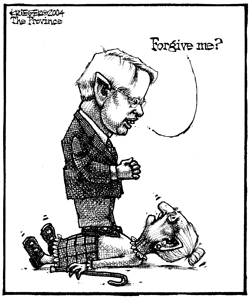
Last week Premier Gordon Campbell rolled out Carole Taylor as his latest star candidate for the May 17 election. He didn’t actually say she was the biggest star he’s ever bagged, but few would quibble with the premise.
Taylor appears to have everything Campbell needs. She’s bright. She’s articulate. She’s charismatic. And she has a fine record of public and community service. She’s been parachuted into a riding that a guinea pig could win, provided the rodent runs as a Liberal. It’s virtually a sure thing she’ll be an MLA in the next legislature – and probably a senior cabinet minister if the Liberals win re-election.
From the viewpoint of the Campbell strategists, however, Taylor has more going for her than just her personal star qualities. For one thing, she comes from the small-l liberal side of the provincial party. That will provide a valuable counterbalance to the more conservative wing, which appears to be gaining power within the party and the cabinet. (Her championing of social causes has been so energetic that one might wonder whether she will have difficulty defending Campbell. She names among her prime accomplishments, for instance, getting a Children’s Advocate for Vancouver. The Campbell government abolished its Child Advocate, and its policies made daycare more expensive.)
The second great advantage Taylor brings to the table for Campbell is that she’s a woman – a successful, well-known woman who’s endorsing the Campbell team.
Poll after poll has shown that women voters don’t approve of Gordon Campbell. The most recent Ipsos-Reid poll, for example, showed that while B.C. Liberals have begun inching ahead of the New Democratic Party as a group, Campbell’s dismal approval ratings remained essentially unchanged. The poll, released March 17, found that while men split evenly (49 per cent for, the same against) on their view of Campbell, likely female voters overwhelmingly rejected him: 62 per cent strongly or moderately disapproved of his performance as Premier, with only 35 percent indicating strong or moderate approval.
Several Liberal strategists have privately said that the party hopes just having Taylor on side will be enough to reverse some of that gender split.
“The press gallery thinks it’s going to be Carole versus Carole,” University of Victoria political science professor Norman Ruff told Election Central. “It’s not going to work that way, because Campbell is the leader of the party. He has to face James himself. He can’t hide behind her (Taylor’s) skirt.”
Taylor herself has made clear she doesn’t want to be held up as some sort of figurehead for the female gender. She wants to run on her own record, views, and policies.
It makes sense for her to do that. For the problems that the Campbell government has with women voters run far deeper than can be patched over with a star female candidate or two. They are a reflection of many decisions made by the Liberals during their first term in office, decisions that had a disproportionately negative effect on British Columbia’s women.
Gender gap emerged early
The first polls after Campbell was elected, when his government was still enjoying an approval rating well over 50 per cent, showed no marked difference between the preferences expressed by male and female voters. But as the Liberals’ popularity began to fall, the drop was far more precipitous for women.
By early 2004, the gender gap had grown so large it was regularly regarded as noteworthy by pollsters from companies like Ipsos-Reid the Mustel Group. The numbers of men supporting Campbell’s Liberals was, for several months, running between 10 and 15 percentage points higher than the number of women. Looking at the approval ratings for Campbell personally, the gap was even greater. As many as two-thirds of all women polled were regularly saying they didn’t like the job Campbell was doing.
In the worst poll, an Ipsos-Reid one in which 800 B.C. residents were telephoned in March, 2004, only five per cent of the women questioned said they “strongly approved” of Campbell’s performance. In contrast, 50 per cent said they “strongly disapproved” of the job he was doing. Another 21 per cent said they “moderately disapproved,” meaning more than seven in 10 women were unhappy with their premier. (For men, the disapproval rating was only 57 per cent.)
Shortly after that poll was made public, the team planning the Liberal re-election was beginning to admit, at least internally, that the gender gap was a problem. The re-election team began to consider whether an advertising campaign could convince women that the Liberals really were on their side. Civil servants in every ministry received calls from the Public Affairs Bureau or the Premier’s office, saying, “Tell us what you’ve done for women lately.”
Tough choices hit women harder
Nearly every area in which the Campbell government was doing well were the ones which tended to appeal most to men, and nearly every area in which the administration was in trouble were the ones that were going to affect women the most.
In some cases, the government’s cuts had hit women’s services directly. The funding for all women’s centres had been eliminated. Huge cuts in the legal aid budget had meant services for family law had been abandoned except for those in the most extreme circumstances. Subsidies for daycare had been reduced for thousands of women, even as new welfare rules were making it mandatory for them to return to the workforce.
Campbell and his ministers would have been horrified that anyone had thought that these cuts were targeted at women. They weren’t. They were, in the Campbell administration’s mind, simply the “tough choices” that had to be made to get the government’s finances under control and to reduce the burden of taxes and regulation on the business sector. But those tough choices had a disproportionate impact on women – and that was what was showing up in the polls.
By contrast, many of the changes that were viewed as more positive were of the sorts that were liked best by men. It started with the 25 per cent across-the-board tax cuts that Campbell announced practically the minute he took office. Polls across Canada, and indeed across North America, show that men view tax cuts, especially income tax cuts, more positively than women do. Women, on the other hand, recognize that big tax cuts are usually accompanied by big service cuts as well – and the women know that the extra money in their pocket won’t be of over-all benefit to them, if they have to spend the savings paying for the services that their children, parents and families still need, but no longer will be easily accessible.
It wasn’t the first decision that Campbell made very early in his mandate that offended many women. Another was to refuse Official Opposition status to the New Democrats since they had been elected in only two seats – and both those MLAs happened to be women. Advocates for women were also disappointed with Campbell’s first cabinet. They had become accustomed to an NDP cabinet where women regularly took on some of the most powerful positions. In Campbell’s first cabinet, Christy Clark became Deputy Premier and also held the Education portfolio – but she was the only woman to be appointed to a major portfolio. Not just Finance and Health Services, but even the more traditionally “soft” ministries like Children and Families, Community, Aboriginal and Women’s Affairs, and Human Resources – all were headed by male members of caucus.
Driving arrests, cabinet defections
Another major factor for many women was Campbell’s arrest for drunk driving in the New Year of 2003. The arrest had much less effect on male voters than on female ones. Campbell’s popularity went up among male voters, while it dropped even further with women. There’s no reason this should be any surprise: consistently, for the past decade or more, women have much more forceful in asserting that drunk drivers should be treated more harshly by the government. Several months later, when Solicitor General Rich Coleman moved to change provincial drunk driving laws in such a way that a high proportion of impaired drivers would escape a criminal record, opponents of the changes immediately brought up the Campbell arrest.
Rumours also circulated about alleged other mysteries in Campbell’s private life. One story about Campbell’s behaviour to women did have some basis in fact. That was the incident between the premier and Surrey MLA Elayne Brenzinger. A lot of women felt a little uncomfortable when Campbell agreed with Brenzinger that during one caucus row, he had told her to “Fuck off” – even though he said it was basically a joke. One might well argue that in the 21st century, there’s should be no difference between how a premier treats his male or female MLAs – but a lot of women, with management styles quite different from the standard male model, didn’t think it was the sign of a good leader that Campbell was saying that to ANY of his caucus members, no matter what their gender. Brenzinger quit the Liberal caucus to sit as an Independent. Though she hadn’t been a particularly high-profile MLA, her departure appeared to signal the beginning of a significant exodus of women from caucus.
The biggest bombshell came when Christy Clark, the one woman who had appeared to be part of Campbell’s inner circle, made it public that she wouldn’t be running again either – and stepped down from cabinet, effective immediately. Clark didn’t say anything against Campbell or the government; she insisted that her resignation was solely because she wanted to spend more time with her son.
But nearly everyone around the legislative buildings knew that Clark hadn’t been happy in the previous few months. She’d lost the education portfolio, and had been downgraded to Children and Family Development. Then the names of Clark’s brother, Bruce, and her husband Mark Marissen, had come up far too often in the wake of the Dec. 28 search warrants executed by police on the legislative buildings. And finally, Clark had privately let it be known that she wasn’t entirely happy about the direction in which the provincial Liberals were headed. A strong federal Liberal herself and a person with a socially small-l liberal view of the world, she was worried that those with a federal Conservative bent and a strongly socially-conservative outlook were gaining ever more sway within the party.
In December 2004, just four months before the official election campaign was scheduled to begin, one of the most detailed Ipsos-Reid polls undertaken showed the Campbell government was still struggling with the gender gap issue. Not only were women much less inclined than men to support the Liberals, but they’d also made it clear why. A high proportion of those questioned agreed the economy was doing very well – but it wasn’t translating into likely votes or seats for the Campbell government.
With or without Carole Taylor, those pesky women’s issues don’t appear likely to just go away.
Veteran political reporter Barbara McLintock will be a regular contributor to Election Central
Portions of this article were excerpted from Liberalized: The Tyee Report on British Columbia under Gordon Campbell’s Liberals. To order, go to: http://thetyee.ca/Contests/2004/12/14/LiberalizedTheBook/. ![]()














Tyee Commenting Guidelines
Comments that violate guidelines risk being deleted, and violations may result in a temporary or permanent user ban. Maintain the spirit of good conversation to stay in the discussion.
*Please note The Tyee is not a forum for spreading misinformation about COVID-19, denying its existence or minimizing its risk to public health.
Do:
Do not: